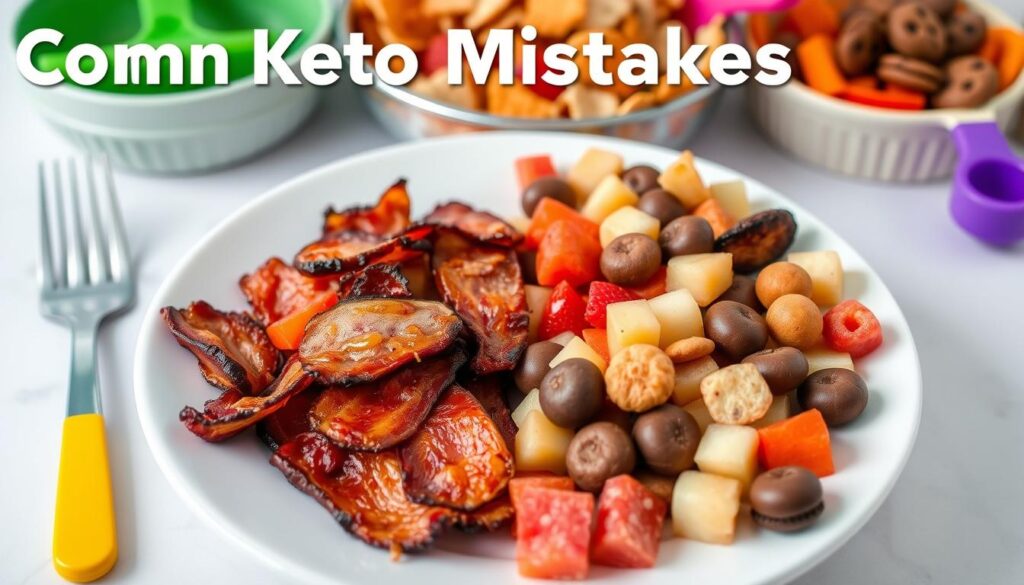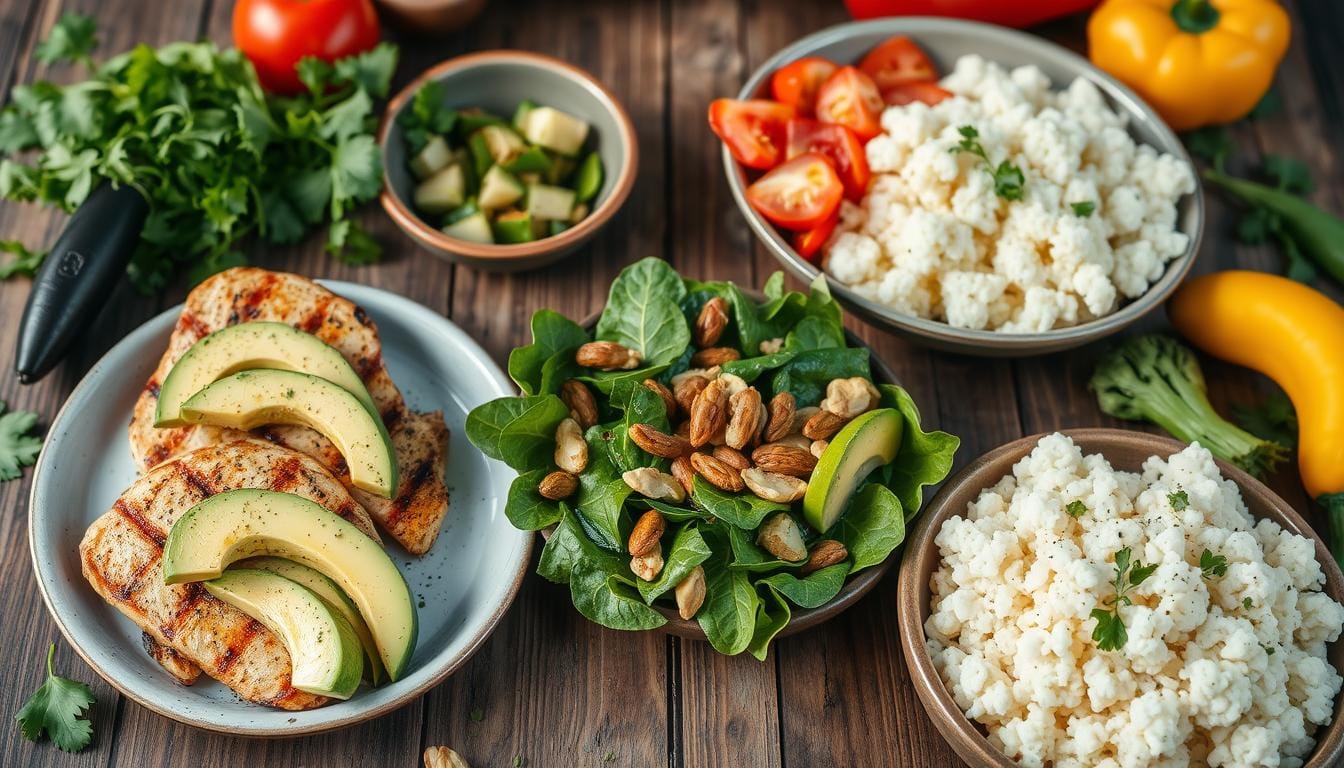The keto diet has become popular for its weight loss and health benefits. It works by making the body burn fat instead of carbs. This makes it a top choice for those wanting to try a low-carb diet.
Many people use the keto diet to lose weight and improve their health. It’s a diet high in fat, designed to help the body burn fat for energy. This makes it a great option for those seeking a low-carb diet.
Eating a high-fat diet is key to the keto diet. This can be hard, but the diet’s benefits make it worth trying. With the right help, anyone can see the keto diet’s benefits, whether for weight loss or better health.
Introduction to the Keto Diet
The keto diet is more than a trend. It’s a real way to lose weight and get healthier. With the right info, anyone can start a keto diet and enjoy its benefits, whether for weight loss or better health.
Understanding the Keto Diet Fundamentals
The keto diet is all about eating a lot of fat. It means making big changes in what you eat. This diet helps your body use fat for energy instead of carbs.
Getting into the keto diet means learning about fat adaptation. This is when your body starts using fat for energy. You’ll feel more energetic and clear-headed. The diet focuses on eating less carbs and more fat.
What Exactly is Ketosis?
Ketosis is when your body uses fat for energy. It happens naturally when you eat a lot of fat. This is a key part of the keto diet.
The Science Behind Fat Adaptation
Fat adaptation is your body learning to use fat for energy. It takes a few weeks. You need to pay close attention to what you eat.
Key Principles of Ketogenic Eating
Ketogenic eating means eating less carbs and more fat. You can eat meats, fish, and healthy oils. This helps you stay in ketosis.
The History and Evolution of Ketogenic Eating
Ketogenic eating has been around for centuries. It started in early medical practices. The history of keto is interesting, showing the diet’s lasting impact.
In the 1920s, it was first used to treat epilepsy. Since then, it has become a favorite for weight loss and health.
Some important moments in the history of keto include:
- The discovery of ketosis by Russell Wilder in 1921
- The development of the first ketogenic diet by Wilder in the 1920s
- The introduction of the Atkins diet in the 1970s, which popularized low-carb eating
- The rise of modern ketogenic eating in the 1990s and 2000s, with the work of researchers like Dr. Stephen Phinney and Dr. Jeff Volek
Today, ketogenic eating is well-known and respected. It has a lot of research backing its benefits for weight loss and health. If you’re looking to improve your health or try something new, knowing the history of keto can help.
Exploring ketogenic eating is more than just a diet. It’s a lifestyle. By following ketogenic eating principles, you can improve your health and enjoy its many benefits.
Health Benefits of Following a Keto Diet
The keto diet is known for its health benefits, making it popular for improving well-being. It helps with weight loss by making the body burn fat more efficiently. This leads to less body weight and better body shape.
This diet also boosts mental clarity and focus. It does this by increasing brain-derived neurotrophic factor (BDNF). BDNF helps grow and keep brain cells healthy. So, people on a keto diet might think more clearly and have a lower risk of brain diseases.
Other benefits include better blood sugar control, less inflammation, and better sports performance. These come from the diet’s high fat, moderate protein, and low carb levels. Knowing these benefits helps decide if the keto diet is good for you.
- Improved blood sugar management
- Reduced inflammation
- Enhanced athletic performance
In summary, the keto diet has many health benefits. It can lead to weight loss, better mental clarity, and more. By following a keto diet well, people can see these benefits and live better.
Potential Risks and Side Effects
When thinking about the keto diet, knowing the risks and side effects is key. A big worry is not getting enough nutrients, especially if the diet isn’t planned well. Dietary restrictions can lead to missing out on important vitamins and minerals.
A good keto diet plan should consider these risks and side effects. It’s important to make sure you get all the nutrients you need. This might mean planning your diet carefully or taking supplements. Also, remember how dietary restrictions can affect your health and happiness.
Some side effects of the keto diet include:
- Bad breath
- Fatigue
- Constipation
It’s important to think about these risks and side effects and the diet’s benefits. Always talk to a healthcare professional before changing your diet a lot.
Foods to Embrace and Avoid on Keto
Following a keto diet means knowing which foods to eat and which to skip. Foods high in fat, moderate in protein, and low in carbs are good. These include meats, veggies, and healthy fats like avocado and olive oil.
But, foods high in carbs and sugar should be avoided. This includes grains, starchy veggies, and sugary drinks. Also, limit processed foods and snacks, as they often have unhealthy ingredients and added sugars.
Keto-Friendly Food List
- Meats: beef, pork, lamb, and poultry
- Vegetables: leafy greens, broccoli, cauliflower, and avocado
- Fats: olive oil, coconut oil, and avocado oil
- Fish and seafood: salmon, tuna, and shrimp
Foods to Eliminate
- Grains: bread, pasta, and rice
- Starchy vegetables: potatoes, corn, and peas
- Sugary drinks: soda, juice, and sports drinks
- Processed foods: snacks, frozen meals, and sugary treats
To enter ketosis and enjoy keto diet benefits, focus on keto-friendly foods. Avoid carbs and sugar. Always check food labels to make sure they fit your keto diet.
| Food | Carbohydrates | Protein | Fat |
|---|---|---|---|
| Beef | 0g | 25g | 15g |
| Broccoli | 5g | 2g | 0g |
| Avocado | 2g | 1g | 10g |
The Keto Flu: What to Expect and How to Handle It
Starting a keto diet often leads to the keto flu. This common side effect can be managed with the right approach. Symptoms include fatigue, headaches, and nausea, but they are usually short-lived.
Common symptoms of the keto flu include:
- Fatigue and weakness
- Headaches and brain fog
- Nausea and stomach discomfort
- Dizziness and lightheadedness
The body’s shift from carbs to fat for energy causes these symptoms. This transition leads to the keto flu.
To tackle the keto flu, drink lots of water and electrolyte-rich drinks. Eating more salt can also help. Rest and gentle exercise can reduce fatigue and other symptoms.

The keto flu is a sign of body adaptation to the new diet. Knowing what to expect and how to manage symptoms helps. With the right approach, the keto flu is just a minor hurdle on the way to better health.
| Symptom | Description | Management Strategy |
|---|---|---|
| Fatigue | Feeling weak and tired | Stay hydrated, get enough rest, and engage in gentle exercise |
| Headaches | Pain and discomfort in the head | Stay hydrated, increase salt intake, and try relaxation techniques |
| Nausea | Feeling queasy and uncomfortable | Stay hydrated, eat small meals, and try ginger or other natural remedies |
Creating Your Personalized Keto Meal Plan
Meal planning is key for a keto diet. It ensures you get the right nutrients and stay in ketosis. First, you need to figure out your macros, like protein, fat, and carbs.
Try for 70-80% fat, 15-20% protein, and 5-10% carbs. But, your needs can change based on age, weight, and how active you are. With your macro goals set, you can plan your meals.
Calculating Your Macros
To find your macros, think about your daily calories and activity. A keto meal planning app or online calculator can help. Also, a good meal prep plan keeps you on track and meets your macro needs.
Meal Timing and Frequency
Timing and frequency matter in meal planning. Eat three main meals a day, with snacks if you need them. Listen to your body and eat when hungry, stopping when full. This helps control your appetite and supports your keto diet.
Shopping and Meal Prep Tips
To succeed with your keto meal plan, you need a good meal prep strategy. This includes planning meals, making a shopping list, and buying keto-friendly foods. Here are some tips:
- Plan meals around your macro goals
- Choose whole, unprocessed foods whenever you can
- Prep meals ahead of time to save time and stay on track
Common Mistakes to Avoid When Starting Keto
Starting a keto diet can be tricky. It’s key to know common mistakes that can slow you down. Not getting enough electrolytes is a big one. It can cause fatigue, headaches, and more. Also, don’t forget about hidden carbs in foods like sauces, condiments, and processed meats.
Here are some common mistakes to watch out for:
- Not getting enough electrolytes, like sodium, potassium, and magnesium
- Overlooking hidden carbs in foods, like sugar, starch, and fiber
- Ignoring fiber intake, which can cause constipation and other digestive problems

Knowing these common mistakes and avoiding them can help you succeed on the keto diet. This way, you can reach your health and wellness goals.
| Mistake | Consequence | Solution |
|---|---|---|
| Not getting enough electrolytes | Fatigue, headaches, and other symptoms | Increase electrolyte intake through supplements or electrolyte-rich foods |
| Overlooking hidden carbs | Slowed weight loss, increased blood sugar levels | Read food labels carefully, track carb intake, and choose low-carb alternatives |
| Neglecting fiber intake | Constipation, digestive issues | Increase fiber intake through whole foods, such as fruits, vegetables, and nuts |
Who Should Not Try the Keto Diet
Before starting a keto diet, it’s key to know who should avoid it. This is due to health conditions or dietary restrictions. People with these needs should look into other diets that fit their health better.
Those with eating disorders should not try the keto diet. It’s too restrictive for them. Also, people with diabetes, kidney disease, or heart disease should be careful or skip it.
Vegetarians or vegans might struggle with the keto diet. It often includes a lot of animal products. Talking to a doctor or dietitian is a good idea to find a better diet.
Here are some key points to consider:
- Consult with a healthcare professional before starting a keto diet, especially if you have any underlying health conditions.
- Be aware of the potential risks and benefits of the keto diet, and consider alternative dietary options if necessary.
- If you have dietary restrictions, work with a registered dietitian to create a personalized meal plan that meets your needs.
Knowing who should not try the keto diet helps people make smart health choices. Always be cautious and talk to a doctor before trying a new diet or lifestyle.
Conclusion: Making an Informed Decision About Keto
The keto diet is a complex approach with both benefits and risks. It can help with weight loss and improve metabolic health. But, it’s not right for everyone. The key is to decide if the keto diet fits your health goals and lifestyle.
Understanding ketosis, its benefits, and side effects is crucial. This way, you can see if the keto diet is right for you. Your health and happiness should always come first when thinking about big diet changes.
Choosing to try the keto diet is a personal decision. With the info from this article, you can make a confident choice. You’ll know if it’s the best fit for your needs and situation.
FAQ
What is the ketogenic (keto) diet?
The keto diet is a way of eating that’s high in fat and low in carbs. It makes your body use fat for energy instead of carbs.
What are the potential health benefits of the keto diet?
The keto diet can help you lose weight and improve your mental focus. It also helps manage blood sugar levels and offers other health benefits.
What are the key principles of ketogenic eating?
The keto diet focuses on eating a lot of fat (70-80% of your calories). You should eat very few carbs (20-50 grams a day). Protein intake should be moderate.
What is the “keto flu” and how can it be managed?
The keto flu is a common side effect when starting the keto diet. It includes symptoms like fatigue, headaches, and digestive issues. To manage it, drink plenty of water, take electrolytes, and slowly get into the diet.
What are some common mistakes to avoid when starting the keto diet?
Avoid not getting enough electrolytes and missing hidden carbs in foods. Also, don’t forget about fiber. Knowing these mistakes can help you succeed on the keto diet.
Who should not try the keto diet?
People with liver or kidney disease, or those with dietary restrictions, should not try the keto diet. Always talk to a healthcare professional before starting, especially if you have health issues.



